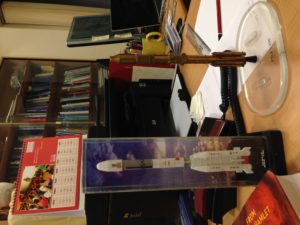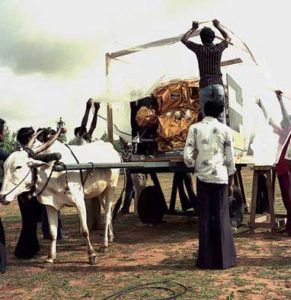By LILIANA GIL, 7/14/2016. June 22nd 2016, yet another great day for ISRO, the Indian Space Research Organization. At around 9:25AM in Sriharikota, 100km North of Chennai, the final commands were given in English. “Nine, eight, seven, six,” rows of frozen-focused scientists were monitoring the launch that would put twenty satellites into orbit in only one mission – a record-breaking event. “Five, four, three,” clients from the US, Canada, Germany, and Indonesia sat behind glass walls in the back of the room, expectantly waiting. “Two, one,” I sipped my coffee in the comforts of my airbnb in Bangalore as I watched the lift-off on my laptop. It was the 36th flight of the Polar Solar Launch Vehicle, a rocket known for its affordable reliability and whose history I had the pleasure of learning about from one of its creators, Professor Rajaram Nagappa.
Few are the space programs that started as civilian enterprises and ISRO is one of them. “I think that’s something really distinctive about the Indian program,” Professor Nagappa stressed, “that’s why it is an exception.” When it was established in the early 1960s, the idea of having a self-reliant system of communications and remote sensing satellites that could help building the nation through TV broadcasting and surveying of natural resources would have sounded like a distant dream. Thumba in South Kerala had been a place for international cooperation around rocket science – with French, American, British, and Russian rockets being frequently launched from there – but it would take more than equatorial proximity to put together a national space program.
Over the course of the next three decades, rocket research in India proceeded firmly but experimentally in the initial stages, almost improvisationally, with flexible deadlines and demands, and always on a tight budget. The story is intricate and it involved many dedicated scientists like Professor Nagappa, as well as “committed leadership and a sense to achieve.” Constrained by scarcity and trade embargoes, ISRO engineers were constantly challenged to substitute imported materials for available, indigenous ones, and they did so by collaborating with local industries that had nothing to do with the space business in the first place – my favorite story being about a match company in Mumbai that became a propellant developer. There were also “free rides” offered by foreign countries in their developmental flights that allowed for the accumulation of know-how despite India’s modest infrastructure – an example being when the French Centre National d’Etudes Spatiales put the Indian satellite APPLE into orbit in 1981. “From these limited opportunities we optimized resources,” Professor Nagappa said with a smile. “ISRO has always been very good at project management. Networking and coordinating was our resourcefulness.”
Today ISRO is well-known for its low-cost achievements. There is an open debate about whether a country with the poverty levels of India should have a space program at all and ISRO’s cost-effectiveness has become an usual argument in its favor. The Mars orbiter Mangalyaan, for instance, became famous for costing almost a tenth of MAVEN, its American counterpart. With fewer ground tests, lower worker costs, and simpler design, the Guardian refers to it as “perhaps the country’s most audacious and successful example of jugaad so far.” And one can say it all goes back to the good old PSLV, the cheap and reliable rocket known among ISRO engineers as their workhorse.
When I asked Professor Nagappa about his proudest moment at ISRO he paused for a second. Memories of one of PSLV’s early flights in the 1990s, when his team was testing the new 100% Indian first-stage motor, came up. I expected a final countdown. For a true expert, however, tension lies not before the lift-off, but after, when the propellant burns and velocity increases and the rocket rises. It takes about one-hundred seconds for the first-stage to burn completely, then the empty motor is ejected and left behind in the air. Professor Nagappa recalled: “yes, those one-hundred seconds seemed like the longest one-hundred seconds we had ever experienced.”


